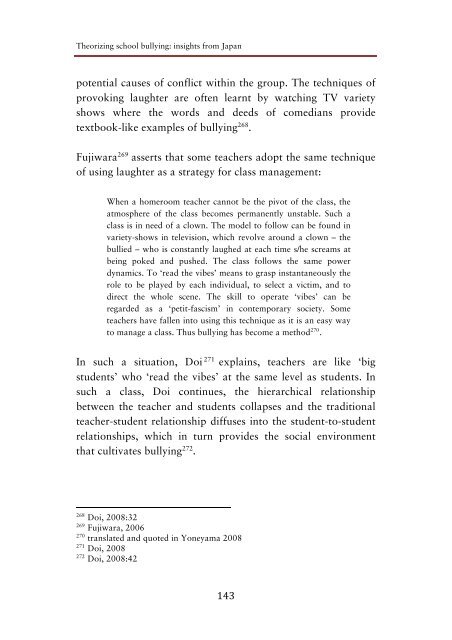You also want an ePaper? Increase the reach of your titles
YUMPU automatically turns print PDFs into web optimized ePapers that Google loves.
Theorizing school bullying: insights from Japan<br />
potential causes of conflict within the group. The techniques of<br />
provoking laughter are often learnt by watching TV variety<br />
shows where the words and deeds of comedians provide<br />
textbook-like examples of bullying 268 .<br />
Fujiwara 269 asserts that some teachers adopt the same technique<br />
of using laughter as a strategy for class management:<br />
When a homeroom teacher cannot be the pivot of the class, the<br />
atmosphere of the class becomes permanently unstable. Such a<br />
class is in need of a clown. The model to follow can be found in<br />
variety-shows in television, which revolve around a clown – the<br />
bullied – who is constantly laughed at each time s/he screams at<br />
being poked and pushed. The class follows the same power<br />
dynamics. To ‘read the vibes’ means to grasp instantaneously the<br />
role to be played by each individual, to select a victim, and to<br />
direct the whole scene. The skill to operate ‘vibes’ can be<br />
regarded as a ‘petit-fascism’ in contemporary society. Some<br />
teachers have fallen into using this technique as it is an easy way<br />
to manage a class. Thus bullying has become a method 270 .<br />
In such a situation, Doi 271 explains, teachers are like ‘big<br />
students’ who ‘read the vibes’ at the same level as students. In<br />
such a class, Doi continues, the hierarchical relationship<br />
between the teacher and students collapses and the traditional<br />
teacher-student relationship diffuses into the student-to-student<br />
relationships, which in turn provides the social environment<br />
that cultivates bullying 272 .<br />
268<br />
Doi, 2008:32<br />
269<br />
Fujiwara, 2006<br />
270<br />
translated and quoted in Yoneyama 2008<br />
271<br />
Doi, 2008<br />
272<br />
Doi, 2008:42<br />
143


